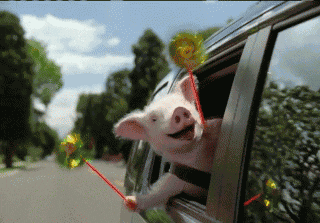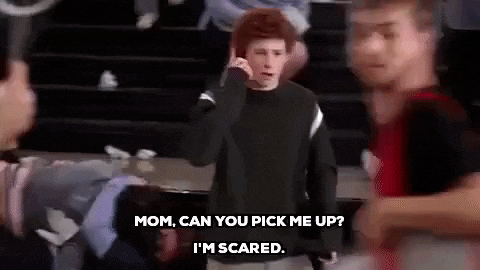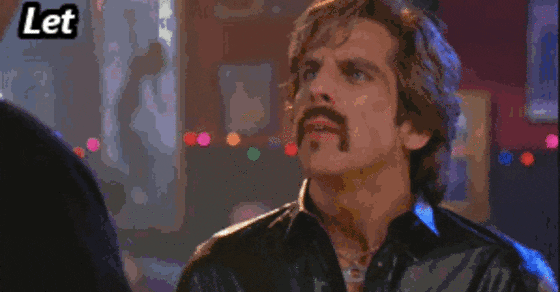
Whatever emotion you’ve conjured out of your customer is going to be a part of the story they will tell to others when they explain their purchase choice.
We are creatures driven by emotion. We flood social media with images and words seeking as many “likes” as possible. We talk about our feelings, we want to spread joy, we need a good cry now and then. We are ruled, very much, by our emotions.
Of course, there are those who will look at a puppy and feel nothing, nothing at all. We don’t trust those kinds of people. No joke, try it, show a picture of a cute puppy to people in your office. Most of them will aawww and oooooh and want to squeeze the puppy or take the puppy home and we like that. But, if there is someone who isn’t bowled over by the cuteness and doesn’t get all the “feels” we think they’re strange, cold or inhuman.
They may simply not like dogs or have had a bad dog experience in their lives and so they don’t have the same reaction. But, we subtly judge those people because they aren’t “feeling right” or feeling at all.
Researchers at the University of Kansas have claimed that humor is the key factor in human sexual selection. The more a man makes a woman laugh the more likely she is to be interested in dating. Women like a man who makes them laugh, makes them feel good.
With all the emotion running around in the world and how quickly emotion makes us, as people, drop our guard and show our true selves, it really makes sense that using emotions in marketing is a good idea.
Basic Physics
Newton’s Third Law of motion states: for every action, there is an equal and opposite reaction. Simply stated one body cannot exert a force on another without experiencing a force itself. Forces always occur in pairs.
Interestingly enough, Newton’s Fourth Law states: if you’re a man, forget it, you cannot do anything right in the eyes of your girlfriend or wife. It’s a little known law and one that got Newton in a lot of trouble, both with his girlfriend and his wife. Also, the Pope was a little grouchy about it too.
The more you put into an emotional appeal, the more of a clear reaction you’re going to get. Now, that doesn’t mean it will always be the kind of reaction you want. We’ve seen many times in our lives an emotional appeal that has seemed to backfire. However, nowhere in Newton’s theory does he say: “ it will all work out the way you wanted it”. Dropping down to one knee and having a Mariachi band appear out of nowhere in the food court of the mall while you very publicly ask your girlfriend to marry you, may seem like a surefire emotional appeal, however, the equal reaction might be equal in displeasure.
Emotions are going to get you a clear reaction, what that reaction is going to be is sometimes anyone’s guess
Appeal to the Heart
If you’re seeking to make a unique and personal connection with your audience through your marketing, nothing gets to the heart of the matter like an emotional appeal.
Emotions connect us on a uniquely human level and one should never underestimate the power of feeling heard or understood. Those are deeply emotional places to be. How often have you tried to placate a wounded friend with “I know just how you feel”?
You try to connect with someone on a feeling, on an emotional level. Once you’ve done that it’s easier to navigate that wounded friend toward safety and feeling better. An emotional connection is a strong connection.
When you have a deep conversation with someone, you have a heart to heart. When you have a technically driven conversation with someone, you have a meeting of the minds. One is emotional, one is cerebral. An emotional appeal is quick, precise and engages deeply. A cerebral appeal takes thought, explanation and the results can take a great deal of time.
Emotions are immediate.
6 Types of Emotional Appeal
An emotional connection will stay with a customer long after the purchase is made. Whatever emotion you’ve conjured out of your customer is going to be a part of the story they will tell to others when they explain their purchase choice. There are 6 important types of emotional appeal:
- Self-esteem
- Authority/experts
- Happy
- Sad
- Fear
- Anger/disgust
These represent a large range of emotions however they can be broken down into 2 categories:
- Positive, feel-good emotions
- Negative emotions, like fear and anger
You may think that being positive, spreading a little sunshine is the best way to reach customers however, the positive choice isn’t always the best choice.
Both positive and negative emotional appeals can be equally persuasive, it just depends on how they’re used and what the desired outcome is. What is the best choice for your business, for your unique connection with your customers? Let’s break down the 6 and see if that helps.
Self-esteem

This approach targets a person’s desire to feel good about themselves. If your product is about enhancing that personal good feeling then a positive, self-esteem appeal is going to increase your customer’s positive impression about your products or service. If you build their self-esteem, they will feel good and thus they will feel good about you and your product.
This was evident in Dove’s Beauty sketches campaign. It started a wave of “love yourself as you are” messages. They used YouTube for this ad, short films about the disconnect that exists in women’s perceptions of themselves. The ad became the most-watched YouTube video of all time. This increased Dove’s visibility and customer connection all over the world.
Authority/Expert

Who can forget: “4 out of 5 dentists surveyed …”? It’s practically a part of our cultural zeitgeist. It brings a credibility, an unbiased opinion to the table. These random experts in the dental field were surveyed and 4 our of 5 say this is the best product for your teeth. The customer sees this and thinks, well, they’re the experts, they know so … and there you have it, you’ve engendered trust, a feeling of safety in your customer.
Air Jordans and Nike really used this to the optimum effect. Everyone wanted to be like Mike.
Here's More on Experts:
Nielsen research has shown that 85% of people seek out trusted, expert content when thinking about a purchase.
69% of people read product reviews by trusted experts before making a purchase.
67% of people agree that an endorsement from an expert makes them more likely to make a purchase.
So, for your campaign, find an expert with enough name recognition that their words, thoughts, and opinions actually carry weight.
Happy

Don’t worry, be happy. That’s such a great, comforting, freeing idea. However, if you give it any kind of thought, it’s insane. You have cancer; don’t worry, be happy. If a doctor said that to you, you’d find a new doctor ASAP. But, if you convey that kind of emotion to a customer in the right way, and they are going to be loyal for life.
People want to be happy. People are willing to push aside the sadness, the strife, the pain and reality of their lives if something will make them happy, even for a short period of time.
The New York Times did a study in which they examined their most shared articles and they discovered that the ones that engendered a feeling of happiness were the ones that got the most shares.
Why? Because joy is contagious and people need to feel happy. If your campaign is just stuffed with positive feels, it is going to make a deep connection with your customers.
Car companies often use this happy tactic to sell products, the new VW Beetle was one such campaign.
Sad

Not everything has got to be roses in Picardy. Do not underestimate the power, the connection in sadness. Remember that old commercial for the children’s charity The Christian Children’s Fund? Sally Struthers standing in and among the wasted figures of small children, their stomachs bloated with famine and she would look at the camera and say, with a cry in her voice; “Welcome to hell.” It was gut-wrenching and it made you feel sad. It was also a very successful campaign to raise money for the charity. People felt sad. People wanted the sadness to stop. People gave money.
More recently the ASPCA tugged on the ol heartstrings with their ad campaign showing dogs and cats in various states of abuse while Sarah McLachlan sings “Angel”. Open the flood gates and let the tears run free.
In terms of marketing, sadness is equally as powerful as happiness in getting people to act or do, or buy.
Fear

Deep down in our amygdala, our lizard brains, we are biologically programmed to react immediately and decisively to fear. It is a very basic, very real, very original human emotional response. We all respond to fear.
Remember those commercials with the big cast iron skillet and the girls holding the egg? Here’s your brain and here’s your brain on drugs. Egg smashes into the pan and, there it is. That was created to scare the bejesus out of drug users.
Putting the surgeon General’s warning on the side of cigarette boxes was designed to speak fear. It did, it does and it works.
The trick with fear campaigns is not to go too far. Not to be too graphic or off-putting then you’ll lose the customer. But, fear in the right measure is a great emotional connection.
Anger/Disgust

These are certainly negative emotions but they can elicit a very positive response. Taking the feelings of disgust and anger and turning them to a more positive approach isn’t easy but, it is certainly powerful.
Look at the Always feminine product’s campaign. They took the rather offensive and un-PC saying “like a girl”, she throws like a girl, she acts like a girl and they turned into a very powerful, very pro-female ad campaign. All the feels were there.
A reimagining or a refocusing on a problem can turn a negative notion into a very positive response. And this can create a very deep, very lasting emotional connection in your customers.
Truth

In order for any of these emotional campaigns to work, they must be grounded in truth. In fact, if you emotionally manipulate your audience and they discover that you’re just using emotion to get customers, it’s going to backfire on you and possibly ruin your brand.
When you embark on an emotional campaign you’re setting up a conversation of trust between you and your customer.
With an emotional campaign, you’re saying to customers; this makes us happy so we think it will make you happy. Or this outrages us and we feel your outrage so we’re connected. Once you’ve made that emotional connection if you damage it, you’re in serious trouble.
There are many examples of this. Look at VW, they advertised environmentally friendly diesel cars. They appealed to the folks who care deeply about the environment, made that emotional connection and then, in 2015, it was discovered that VW has been cheating on emissions tests on diesel cars in the US for seven years. The brand took a serious hit.
Activa yogurt claimed it had special bacterial ingredients. They went further saying that the yogurt was “Clinically” and scientifically proven to help boost your immune system and help regulate digestion. They even had an “authority” figure, Jamie Lee Curtis, promoting the product in ads. The product itself was sold at 30% higher than other similar products and people, especially women, felt an emotional connection because of MS, Curtis’ involvement. A lawsuit was lodged in 2008 and Dannon, the makers of Activa, was fined $45 million and forced to remove “clinically” and “scientifically” form the labels.
We Have the Internet
Because of the internet and our access to all the information about all the things in the world, it makes it harder for companies to use emotion to make a connection that is based on a lie. Also, we now live in an exceptionally litigious society so, playing with an emotional connection can not only damage your brand it can cost you a significant amount of money as well if someone gets a bee in their bonnet about your product.
In Our Current World
Emotional marketing can be very powerful and can build brand loyalty however if it’s used badly or deceptively, it can cause you serious headaches. Today’s consumers are much more smart and savvy than they have been in the past. If you’re trying to get one by on the average consumer, chances are it will backfire.
The reaction to an emotional campaign can be deep and long-lasting, You can strengthen a brand, get it more of an audience and reach more people but be cautious, if you have customers opening up to you, believing in your brand they can easily turn against you if they find you’re emotionally manipulating them with no truth under it.
Belief if a big emotional factor. Trusted brands and brands that we have used forever have won a place in our emotional landscape by working hard and never giving us reason to doubt them. Emotions have great power and, as Uncle Ben said, the Spider-Man Uncle Ben, not the instant rice Uncle Ben, with great power comes great responsibility. Connect emotionally with your customers but also, tell them the truth.

